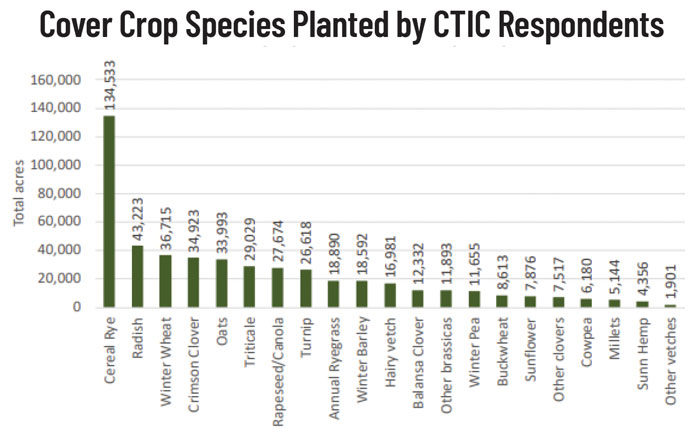No-Till Farmer
Get full access NOW to the most comprehensive, powerful and easy-to-use online resource for no-tillage practices. Just one good idea will pay for your subscription hundreds of times over.

RYE REPEAT. For the CTIC survey, cereal rye was, by far, the most commonly planted cover crop species. From 575 respondents asked to provide their planted acreage for a list of cover crop species, cereal rye covered 134,533 acres. The next most popular species was radish, with 43,223 acres, followed closely by wheat (36,715 acres), clover (34,923) and oats (33,993). Source: 2023 CTIC National Cover Crop Survey
A national survey about farmers’ cover crop practices reveals similar goals and opportunities with cover crops compared to No-Till Farmer’s annual Cover Crops Operational Practices Survey (CCOPS), but no-tillers have an advantage with their ability to plant green.
The Conservation Technology Innovation Center (CTIC) recently released results from the National Cover Crop Survey. Overarching themes represented in the results of both surveys include a low number of farmers who are grazing their cover crops and stagnant savings on fertilizers, but a larger portion of CCOPS respondents are planting green compared to the CTIC survey.
The majority of respondents for both surveys are no-tilling. According to the 2022-23 survey conducted by CTIC, 58% of respondents are no-tilling. Comparing those data with the results from No-Till Farmer’s CCOPS, 91% reported using no-till.
For the total pool of CTIC survey respondents, about 72% said they farm less than 1,000 acres, while about 28% said they farm 1,000 or more acres.

RAISING RYE. In the No-Till Farmer survey, the top 5 most common cover crop species were cereal rye (78%), radish (46%), oats (39%), crimson clover (30%) and rapeseed (27%). Source: 2023 Cover Crops Operational Practices Survey
For the CCOPS, 68% of the respondents farm less than 1,000 acres, while 18% of the respondents farm 1,000-1,749 acres. On average, growers who responded to the CCOPS seeded 457 acres of cover crops in 2022, compared to an average of 413 acres planted to cover crops in this year’s CTIC survey.